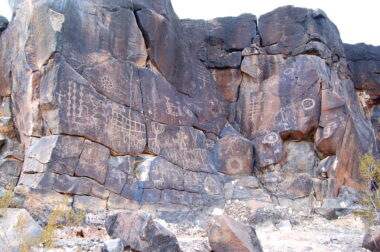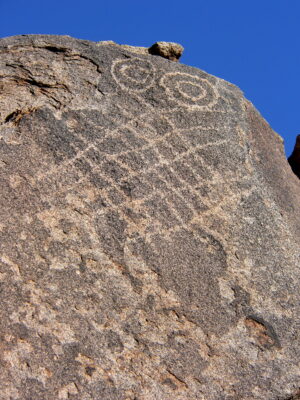

Join Dr. Patrick Lyons, ASM Acting Associate Director and Head of Collections, and Mike Jacobs, Archaeological Collections Curator, for a two-hour seminar focused on Hohokam painted pottery. Lyons and Jacobs will teach about the typology and chronology of Middle Gila Buff Ware, using whole vessels and sherds from ASM’s collections. They will address related wares and types as well, including Tucson Basin Brown Ware and San Carlos Red-on-brown. Also included in the program are a discussion of recent research on Hohokam painted pottery, a tour of the Agnese and Emil Haury Southwest Native Nations Pottery Vault, and an opportunity for participants to test their new knowledge by sorting sherds. A compilation of published sources on ceramic analysis and handouts synthesizing typological and chronological information will be provided. To register email Katherine Cerino. Seminar is limited to 25 people.
Suggested Readings:
Abbott, David R.
2000 Ceramics and Community Organization Among the Hohokam. University of Arizona Press, Tucson.
2009 Extensive and Long-Term Specialization: Hohokam Ceramic Production in the Phoenix Basin, Arizona. American Antiquity 74(3):531-557.
Abbott, David R., Alexa M. Smith, and Emiliano Gallaga
2007 Ballcourts and Ceramics: The Case for Hohokam Marketplaces in the Arizona Desert. American Antiquity 72(3):461-484.
Colton, H.
1953 Potsherds: An Introduction to the Study of Prehistoric Southwestern Ceramics and Their Use in Historic Reconstruction. Museum of Northern Arizona Bulletin 25. Northern Arizona Society of Science and Art, Flagstaff.
Gladwin, Harold S., Emil W. Haury, E. B. Sayles, and Nora Gladwin
1937 Excavations at Snaketown: Material Culture. Medallion Papers No. 25. Gila Pueblo, Globe.
Haury, Emil W.
1945 The Excavation of Los Muertos and Neighboring Ruins in the Salt River Valley, Southern Arizona, Based on the Work of the Hemenway Southwestern Archaeological Expedition of 1887-1888. Papers of the Peabody Museum of American Archaeology and Ethnology Vol. 24(1). Harvard University, Cambridge.
1976 The Hohokam, Desert Farmers and Craftsmen: Excavations at Snaketown, 1964-
1965. University of Arizona Press, Tucson.
Heckman, Robert A., Barbara K. Montgomery, and Stephanie M. Whittlesey
2000 Prehistoric Painted Pottery of Southeastern Arizona. Technical Series No. 77. Statistical Research, Inc., Tucson.
Kelly, Isabel T., James E. Officer, and Emil W. Haury
1978 The Hodges Ruin: A Hohokam Community in the Tucson Basin, edited by Gayle H. Hartmann. Anthropological Papers of the University of Arizona No. 30. University of Arizona Press, Tucson

Three Tumacácori Missions, guided by Jeremy Moss, Archaeologist, Chief of Resource Management, Tumacácori NHP
Tumacácori National Historic Park protects three Spanish colonial mission ruins in southern Arizona: Tumacácori, Guevavi, and Calabazas. The adobe structures are on three sites, with a visitor center at Tumacácori. These missions are among more than twenty established in the Pimería Alta by Father Kino and other Jesuits, and later expanded upon by Franciscan missionaries. The name “Tumacácori” may have been derived from two O’odham words, chu-uma and kakul, having reference to a flat, rocky place. Father Kino established it as a mission in January 1691, one day before Guevavi, making it the oldest mission site in Arizona.
This trip can take 15 participants, and we must all fit into four high-clearance vehicles (with room for our guide). As you reserve a place, please let me know if you have a high-clearance vehicle and how many it can hold. We will rendezvous at a location near I-19 and Irvington at 8 a.m., jump into four vehicles, and head to Tumácacori. Bring a packed lunch to eat at either Guevavi or Calabasas. We expect to be back at the rendezvous point by 3 p.m.
To register for the trip contact Lynn Ratener.
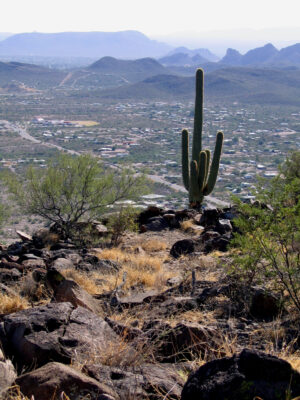
WAITING LIST ONLY
Tumamoc Hill just west of the Santa Cruz river in downtown Tucson is a trincheras site with occupations going back to 500 BC. There are also a large number of Hohokam petroglyphs. Our leaders will be Hohokam scholars Paul and Suzanne Fish and Peter Boyle and Gayle Hartmann who led the AAHS rock art recording project on the hill. To register email Katherine Cerino. The trip is limited to 30 people.
Evelyn Billo and Robert Mark have been leading a multi-year effort to document the extensive rock art along the Gila River between Gila Bend and Yuma. President’s Weekend they will lead a trip for AAHS to see some of sites. We will meet in Gila Bend at 10:00 am on Saturday, February 18th and proceed to the Howard Wells site which is about an hour beyond Gila Bend. On Sunday we will go to the Sears Point site. We plan to leave Sears Point around 3:00 on Sunday so should be home by 6:00 p.m. We will have two or three leaders so we can split into groups based on walking ability and desire. There is a great deal to see without extensive hiking and a great deal to see which involves hiking. We will plan to spend the night in Gila Bend although primitive camping maybe available at the Howard’s Well Site. Camping is no longer allowed at Sears Point. High clearance vehicles are required so we will carpool from Gila Bend. To register for the trip contact kcerino@gmail.com and indicate if you have a high clearance vehicle.

The new AAHS T-shirts designed by Janine Hernbrode and featuring Hohokam burden carriers over a petroglyph design from Cerro Prieto are now available in our on-line store.
Kiva Book Review Vol 76, No 4
Reviewed by Ruth M. Van Dyke
Ancestral Landscapes of the Pueblo World by James E. Snead. 256 pp., 4 illustrations,
16 maps, Acknowledgments, Index, References Cited. The University of Arizona
Press, Tucson, 2008. $45.00 (Cloth). ISBN 978-0-8165-2308-5
To read review (PDF format) Ancestral Landscapes of the Pueblo World

ANCESTRAL HOPI PAINTED POTTERY SEMINAR
Join Dr. Patrick Lyons, ASM Acting Associate Director and Head of Collections, for a two-hour seminar focused on ancestral Hopi painted pottery. Dr. Lyons will teach about the typology and chronology of Jeddito Yellow Ware, Jeddito Orange Ware, Winslow Orange Ware, and Hopi White Ware, using whole vessels and sherds from ASM’s collections. He will address the key research questions that archaeologists have explored using these wares, including exchange, migration, and the origin of the katsina religion. Also included in the program are a tour of the Agnese and Emil Haury Southwest Native Nations Pottery Vault and an opportunity for participants to test their new knowledge by sorting sherds. The seminar will conclude with a question-and-answer session. A compilation of published sources on ceramic analysis and ancestral Hopi pottery and handouts synthesizing typological and chronological information will be provided. The seminar will be held from 10 am until noon on Friday, May 20th. To register contact Katherine Cerino.
Suggested Readings:
Colton, Harold S.
1953 Potsherds: An Introduction to the Study of Prehistoric Southwestern Ceramics and Their Use in Historic Reconstruction. Museum of Northern Arizona Bulletin 25. Northern Arizona Society of Science and Art, Flagstaff.
Hays, Kelley Ann
1991 Ceramics. In Homol’ovi II: Archaeology of an Ancestral Hopi Village, edited by E. Charles Adams and Kelley Ann Hays, pp. 23-48. Anthropological Papers of the University of Arizona No. 55. University of Arizona Press, Tucson, AZ.
Hays-Gilpin, Kelley Ann, and Steven A. LeBlanc
2007 Sikyatki Style in Regional Context. In New Perspectives on Pottery Mound Pueblo, edited by Polly Schaafsma, pp. 109-136. University of New Mexico Press, Albuquerque.
LeBlanc, Steven A., and Lucia R. Henderson
2009 Symbols in Clay: Seeking Artists’ Identities in Hopi Yellow Ware Bowls. Papers of the Peabody Museum of Archaeology and Ethnology, Vol. 84. Harvard University, Cambridge.
Lyons, Patrick D.
2003 Ancestral Hopi Migrations. Anthropological Papers of the University of Arizona No. 68. University of Arizona Press, Tucson.
ANCESTRAL HOPI PAINTED POTTERY SEMINAR AGENDA
Introduction
Typology and Chronology
•Wares and Types
▪Genus and Species
▪Tradition of pottery making associated with a place vs. change
through time
Research Foci
•Sourcing
•Migration
•Exchange for cotton
•Exterior “glyphs”
•Origin of Sikyatki Style
•Uto-Aztecan Flower World and katsina religion
Tour of the Agnese and Emil Haury Southwest Native Nations Pottery Vault
Sherd Test
Question and Answer Session
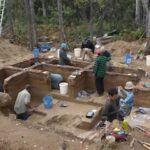
The Tanana River Valley region in interior Alaska has one of the longest archaeological records in North America dating back to 14,000 calendar years ago, at the end of the Ice Age. Several multi-component sites including Upward Sun River, Gerstle River, Mead, Broken Mammoth, Swan Point, and the Bachner Site, have provided well-preserved fauna, organic implements, lithic assemblages, and cultural features in secure stratified contexts. These and other sites are situated in windblown silts (loess) on bedrock bluffs, alluvial terraces, and sand dune deposits, providing avenues for exploring changes in human-environment interactions in the Subarctic. This presentation will primarily focus on the results of recent excavations and archaeological and geological research conducted at Upward Sun River.
The Upward Sun River, or /Xaasaa Na’/ in Upper Tanana Athabascan, site is situated on a stabilized sand dune that is capped with over 2 meters of loess. Since 2007, we have identified four occupations in stratified contexts dating between 13,200 and 10,000 calendar years ago. The rapid deposition of sediments aided in the exceptional preservation of organic remains and integrity of the archaeological record. Most spectacular is the discovery of a young child, Xaasaa Cheege’ Ts’eniin’ (Upward Sun River Mouth Child), who was cremated within a residential structure. This represents the oldest Arctic/Subarctic human remains and residential structure, and one of the oldest in the Western Hemisphere. We report on our analyses of animal and floral remains from the site, and explore the nature of human land use patterns in the Tanana Basin. We integrate these results in the context of regional geoarchaeological investigations on the evolution of the middle Tanana River landscape, terminal Pleistocene and early Holocene environments (20,000-6,000 calendar years ago) and climate change, and prehistoric hunter-gatherer/environment interactions in the region.
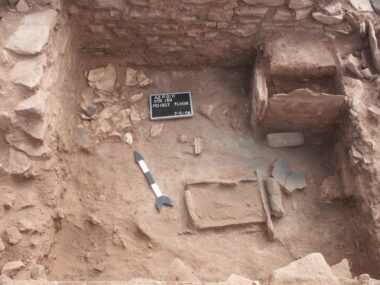
Since 1985, E. Charles (Chuck) Adams has directed the Homol’ovi Research Program of the Arizona State Museum excavating five of the seven pueblos in the Homol’ovi Settlement Cluster. These settlements are integral to Hopi oral history and were variously occupied from 1260-1400. In addition to excavations, associate HRP director, Richard C. Lange, directed a large survey project from 1985-1989 that documented 400 sites covering more than 25 sq. miles. Five of these sites have also been excavated, including two field houses and a 20-room pueblo dating to the 1300s, a small pueblo dating about 1200, and a multi-component site adjacent to the visitor center with occupation spanning from 600-1200 CE. Most of this research was done to help create and support Homol’ovi (Ruins) State Park. Adams will discuss the many contributions to knowledge made by this research.
Starting in June 2011, in conjunction with Lange and Dr. Vincent M. LaMotta (University of Illinois, Chicago) Adams launched a new field project via a School of Anthropology fieldschool at Rock Art Ranch about 17 miles southeast of Winslow. The goal of research at the ranch is to better understand the history of the region prior to the development of the large pueblos in the late 1200s and to evaluate the relationship of the archaeology of the ranch to the famous petroglyph site in adjacent Chevelon Canyon, which has glyphs dated as early as 6500 BCE. A brief summary of this work and its goals will also be presented.
